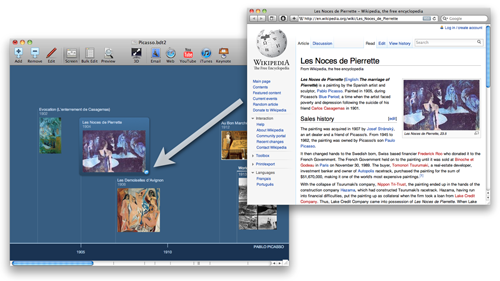Using Event Links
Event links are a powerful tool for creating interactive timelines.

About Links
Use Event Links to connect multimedia and background information with events in your timeline chart. Individual events can link to local files stored on your computer such as movies, images, presentations, documents, or even other Timeline 3D charts. Events can also link to websites.
Local Paths
Use a local file path to link an event to a file stored on your hard drive. To connect a file with an event, double click the event to switch to edit mode. Click the blue arrow at the bottom of the event edit form to reveal the advanced settings. Then click the Link text box and drag a file to the text box or manually enter its path in the Link text box. An example of a valid path is “/users/myname/MyMovie.mov”
Website URLs
Website URLs can be entered in the same way. Double click the event to put it in edit mode. Click the blue arrow at the bottom of the event edit form to reveal the advanced settings. Then click the Link text box and drag a URL from your browser address bar or manually enter it. An example of a valid website URL is “http://www.beedocs.com”
Following a Link
To launch the website or local file associated with an event, first make sure the event is selected (but not in edit mode). A small blue arrow will be displayed in the lower right of the event if it has a link associated with it. Click the blue arrow to launch the linked resource in its default application.
To launch the website from a 3D presentation, click on the link button on the 3D Controller or use key command “L” to launch your browser. To return to your timeline chart, click on the Timeline 3D icon in your dock.
Tips
- For very complex timelines, consider making an overview timeline with summary events that link to detailed timeline which describe sub-events. For example a “Blue Period” event in a Picasso timeline could like to a detailed Blue Period timeline.